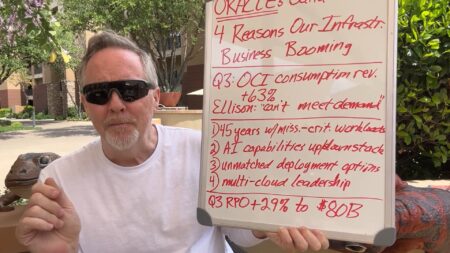Riding booming results from its Financial Management SaaS apps as well as its recently acquired Planning apps, Workday says a number of customers are now buying the financial apps without already being users of its flagship HCM apps, signaling a new level of marketplace awareness and acceptance of Workday Financials.
Across the board, Workday reported excellent results for its fiscal 2019 fourth quarter (ended Jan. 31): subscription revenue jumped 37% to $674 million and full-year subscription revenue was $2.39 billion, up 33%. And adding in revenue from its professional services business, Workday in total grew 32% to $2.82 billion.
But for a couple of reasons, the big story is how Workday Financials has become self-sustaining and is no longer sold primarily as follow-on to Workday’s market-leading HCM suite.
First, these results indicate that Workday Financials has become a mainstream product for mid-sized and large corporations and is no longer a trial-type experiment. It’s become a viable product in every respect, and Workday continues to develop a wide range of ways to demonstrate to customers the value of pairing up its HCM applications with its Financials—or vice-versa, given this latest news.
Second, the company’s acquisition 9 months ago of Adaptive Insights and its highly regarded business-planning applications gives Workday a full cloud ERP suite that puts it squarely up against primary competitors Oracle and SAP in the marketplace—and now that Adaptive Insights is a unit of Workday, the sales of its business-planning solutions are beating expectations.
And although Oracle founder Larry Ellison would probably prefer to have been wrong about this, the strong results from Workday underscore a prediction he’s been making for the past 18 months or so: that Oracle’s primary competitor in SaaS is not traditional rival SAP but is in fact Workday.
*******************
RECOMMENDED READING FROM CLOUD WARS:The World’s Top 5 Cloud-Computing Suppliers: #1 Microsoft, #2 Amazon, #3 Salesforce, #4 SAP, #5 IBM
Amazon Versus Oracle: The Battle for Cloud Database Leadership
As Amazon Battles with Retailers, Microsoft Leads Them into the Cloud
Why Microsoft Is #1 in the Cloud: 10 Key Insights
SAP’s Stunning Transformation: Qualtrics Already “Crown Jewel of Company”
Watch Out, Microsoft and Amazon: Google Cloud CEO Thomas Kurian Plans To Be #1
The Coming Hybrid Wave: Where Do Microsoft, IBM and Amazon Stand? (Part 1 of 2)
Oracle, SAP and Workday Driving Red-Hot Cloud ERP Growth Into 2019*********************
Workday said it signed 79 new Financials customers in its Q4—representing revenue growth of more than 50%—with the Adaptive Insights planning apps also continuing to find strong acceptance as standalone products as well as in combination with either Workday Financials or HCM.
“One interesting new trend we’re beginning to see is that large enterprise companies are now starting their finance and HR journeys with Workday Financial Management,” Workday CEO Aneel Bhusri said on last week’s earnings call.
This “new development” underscores the “growing awareness of our Financial Management applications as well as high levels of satisfaction experienced by our finance customers over the past several years,” Bhusri said

“And we saw strong momentum in our second full quarter of selling the Adaptive Insights Business Planning Cloud,” he added, noting that Workday not only signed more than 200 new Planning customers in the quarter, but also “achieved great success bringing Adaptive Insights into our new large-enterprise opportunities as add-on sales into the existing Workday customer base.” The Workday sales team was able to add Planning into more than 50 new Workday deals and also into 30 existing Workday accounts, the company said.
Here’s how Bhusri sized up the competitive landscape in the strategically vital Cloud ERP segment:
“When you look at the viable finance products in the cloud, it’s actually a pretty short list,” he said in response to an analyst’s question on the call.
“So as companies look to transform their finance operations and move to the cloud, it frankly tends to be much more about us and Oracle—SAP doesn’t really have a native cloud story, and as a result they don’t show up in the conversations as much.”
Bear in mind that, as we’ve said before here in Cloud Wars, for tech vendors, the Law Of The Cloud is to get as big as you can as fast as you can across as many layers or slices of the cloud as you can—and this accelerated transformation by Workday from plucky little independent HCM vendor to a broad-line provider of enterprise SaaS solutions is impressive. For instance:
- Workday’s Prism Analytics posted a record number of new customers and again experienced growth of more than 100% in the annual contract value (ACV) of those deals.
- Partners saw “robust growth in their Workday practices,” said CFO Robynne Sisco, “and we will continue our tight alignment with them to ensure customers have successful implementations that support the highest levels of customer satisfaction and business value.” For Q1, Workday is projecting professional-services revenue to be about $120 million (up 24%), and for the year, $500 million (up 15%).
And that increasingly broad set of timely solutions is fundamentally changing the way in which enterprises view Workday.
“One of the reasons we’re getting into these Financials-first conversations is that the Adaptive products are opening the door to the CFO earlier or in some cases, they’re opening the door for the first time, and then we can have that broader conversation,” Bhusri said in the Q&A portion of the call.
“So I wouldn’t underestimate the power of how we can now have a conversation not just around core Financials but also around the Planning products from Adaptive and also the Prism Analytics on the analysis side. We can tell the full story around planning, execution and analysis—and that’s key for the CFO community and the finance organizations,” Bhusri said.
Workday’s always prided itself on having lots of happy customers, and that outcome becomes even more valuable as the Workday becomes able to offer more solutions to those companies that have already come to know and trust the vendor, Bhusri said later in the call.
“Once the customers are live, they’ll look to extend the footprint so getting customers into production as quickly as possible opens up the door for Learning, for Recruiting, for Prism Analytics, for Planning, and for Time Tracking,” he said.
“We now have more than 2,600 customers and 70% of those are already in production, and that’s created a very big base of opportunities for us to go back in and see how else we can help them.”
Disclosure: At the time of this writing, SAP and Oracle are clients of Evans Strategic Communications.
Subscribe to the Cloud Wars Newsletter for twice-monthly in-depth analysis of the major cloud vendors from the perspective of business customers. It’s free, it’s exclusive, and it’s great!







